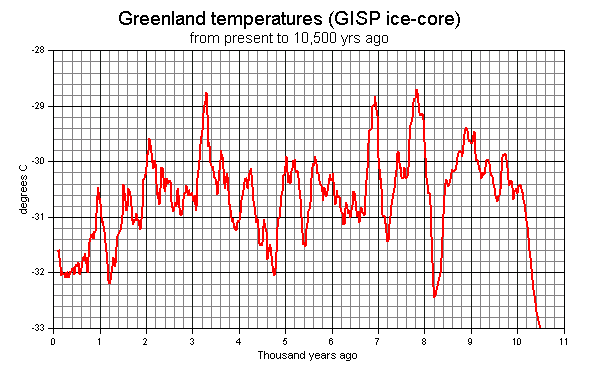National Science Foundation-funded climate science paper does not show what alarmists claim
On March 8, 2013, a new scientific paper, “A Reconstruction of Regional and Global Temperature for the Past 11,300 Years”, was published in the Washington DC-based journal “Science”. Authored by three Oregon State University (OSU) scientists, Shaun Marcott, Peter Clark and Alan Mix as well as Jeremy Shakun of Harvard, the paper attempted to show that twentieth century “global temperature” rise was unusual when seen in the context of the period since the end of the last glacial.
- Note: The last glacial period, extending from about 120,000 years ago until about 10,500 years ago, is commonly, though incorrectly, referred to as “the last Ice Age.” In fact, we are still in the Ice Age, a period that extends all the way from the present back to over two million years ago. It will undoubtedly continue for at least several millennia more. During this Ice Age, Earth has gone through long cold periods called glacials and shorter warm periods referred to as interglacials. We are now in an interglacial warm period, called the Holocene, as part of the on-going Ice Age.
In reality, the OSU/Harvard research team did not demonstrate that the past century’s warming is unusual. For reasons discussed below, it was not even possible for the researchers to rationally come to such a conclusion based on the data they collected and the computational methods they employed.
Yet, media trumpeted the research as strong evidence that recent warming is unusual. Here is an example:
CKNW radio, Vancouver: “EARTH IS AT IT’S HOTTEST ITS EVER BEEN: NEW STUDY SAYS”
“In just one century the temperature of the earth has gone from it’s coldest since the Ice Age to it’s hottest. In the last 11,300 years a heat spike like this has not occurred, this according to one of the authors of a new long-term study that says Global warming is epic.
“Scientists went back that many years to complete their study. They found that the first decade of the 20th century was colder than 95% of the past 11,300 years, while the first decade of this century is at it’s hottest.”
- Note: Very much to CKNW‘s credit, they eventually presented both sides of the issue. First, at 3:30 pm on March 24 (the date of the above quote), they had paper author Jeremy Shakun on air – listen to the Shakun interview in CKNW’s audio vault here by selecting March 24, and then choosing 3:00 pm and moving the slider to the 33:42 mark. A week later they then brought me on to present the other side of the argument. CKNW host Sean Leslie’s interview with me may also be heard in the CKNW audio vault by selecting 5:00 pm on March 31, and moving the slider to the 34:19 mark. This is an example of what all media should be doing on such controversial topics.
In fact, even the paper’s author’s did not conclude that today’s temperatures are the highest in the past 11,200 years. The researchers wrote in the abstract of their paper:
“Current global temperatures of the past decade have not yet exceeded peak interglacial values but are warmer than during ~75% of the Holocene temperature history.”
Why didn’t reporters ask what happened in the 25% of the record where, according to the OSU/Harvard researchers, temperatures were at least as high as today? Why was it warmer 8,000 years ago during the “Holocene Optimum” when the first civilizations were being established in the Fertile Crescent region of the Middle East? It certainly was not caused by human activities.
 Oregon State University/Harvard study is countered by numerous scientific papers that demonstrate many periods in the Holocene that were warmer than today. Concerning the above graph, ICSC Science Advisory Board member climatologist Dr. Tim Ball explains: “This record shows you can argue it was warmer than today for most of the last 10,000 years. It shows temperatures up to 3°C warmer than at present, and a measure of the range of variability in relatively short time periods. You can also argue that the world has cooled from the peak of warming approximately 3,000 years ago.”
Oregon State University/Harvard study is countered by numerous scientific papers that demonstrate many periods in the Holocene that were warmer than today. Concerning the above graph, ICSC Science Advisory Board member climatologist Dr. Tim Ball explains: “This record shows you can argue it was warmer than today for most of the last 10,000 years. It shows temperatures up to 3°C warmer than at present, and a measure of the range of variability in relatively short time periods. You can also argue that the world has cooled from the peak of warming approximately 3,000 years ago.”
Besides the press’ penchance for sensationalism in support of the climate scare, part of the reason media did not report properly on the paper was that OSU (see news release here), the (American) National Science Foundation (NSF), and the journal Science exaggerated the paper’s findings.
Let’s look at NSF announcements, for example.
“The last century stands out as the anomaly in this record of global temperature since the end of the last ice age.” Candace Major, program director in the NSF Division of Ocean Sciences asserted. “This research shows that we’ve experienced almost the same range of temperature change since the beginning of the industrial revolution as over the previous 11,000 years of Earth history – but this change happened a lot more quickly.”
But even the OSU/Harvard scientists tell us that such a conclusion is unwarranted. The proxy data (i.e., that before recent thermometer measurements) has too low a temporal resolution to even see changes as quick as those that occur over a one century-long time frame. Shakun wrote on the New York Times blog, DotEarth:
”we can’t be sure there aren’t any abrupt global warming blips during the Holocene similar to the current one due to chronological uncertainties and the relatively low time resolution of our global temperature reconstruction.”
Shaun Marcott, the secondary author said:
”We cannot say whether this change is unique across the entire Holocene because of the resolution (i.e., the sampling of temperature per unit time) of the entire dataset is about 120 years, and the nature of the Monte Carlo simulations smooth everything out to less than about 300 years. [So] it would be incorrect to say the rate is greater than anything else seen in the past 11,000 years. When looking at our reconstruction of temperature it appears this way. [But] it is, in fact, just a resolution issue related to this dataset.”
If one averaged temperatures over the past 300 years, the resulting statistic would be lower than that of much of the past 11,000 years because the 18th and 19th centuries were so cold. 200 years of low temperatures more than balance 20th century warming when “smoothing” three centuries of data into a single average data point. So, this computational method would have hidden 20th century warming and may very well have hidden numerous century-long temperature spikes earlier in the record. Of course we know about 20th century warming because of the use of modern temperature sensing devices, but no such instruments existed before the 17th century.
Australian science communicator Joanne Nova explains this in more detail here, citing Marcott et al as saying there is “…essentially no variability preserved at periods shorter than 300 years…” This means that warming in the 11,300 year proxy record exactly like that which occured in the 20th century would not be seen.
Regardless, the data used in the most recent decades analyzed by the report is too sparse to allow it to be meaningfully compared with past centuries. Even the authors admitted that the temperatures they determined for the last 60 years of the record are not “robust”. When questioned by analyst Steve MacIntyre about this, Marcott responded:
“the reconstruction over the past 60 yrs before present (the years 1890 − 1950 CE) is probably not robust because of the small number of datasets that go into the reconstruction over that time frame.”
That the NSF, the organization that funded the research, exaggerated its findings is not surprising. After all, they are a federal agency with $7B in annual funding from the taxpayer and their director was appointed by President Barack Obama who promotes the climate scare. Official U.S. government policy therefore supports the global warming alarm so naturally the NSF would promote it too.
I’ll be analyzing this paper further in future blog postings as it is deconstructed by the climate realist community but it is clear that, with the help of OSU, NSF and the journal Science itself, the media were bamboozled into believing yet another bogus climate scare story.
____________________
Tom Harris is Executive Director of the International Climate Science Coalition, and an advisor to the Frontier Centre for Public Policy. He thanks climatologist Dr. Tim Ball for his valuable scientific assistance in preparing for the March 31 CKNW radio interview cited above.


